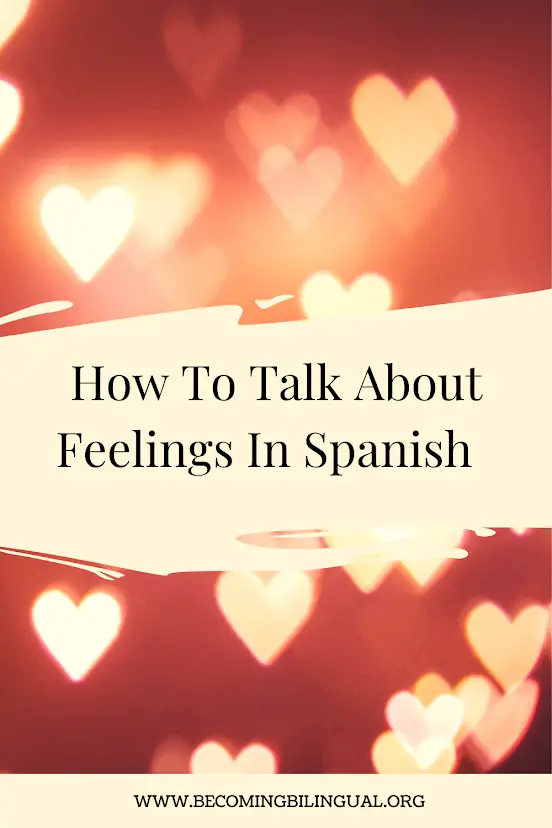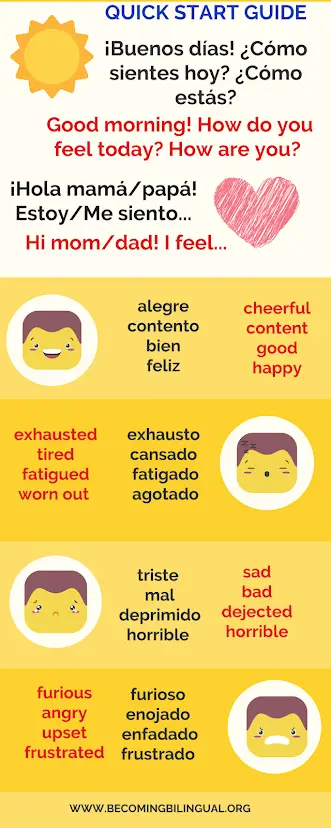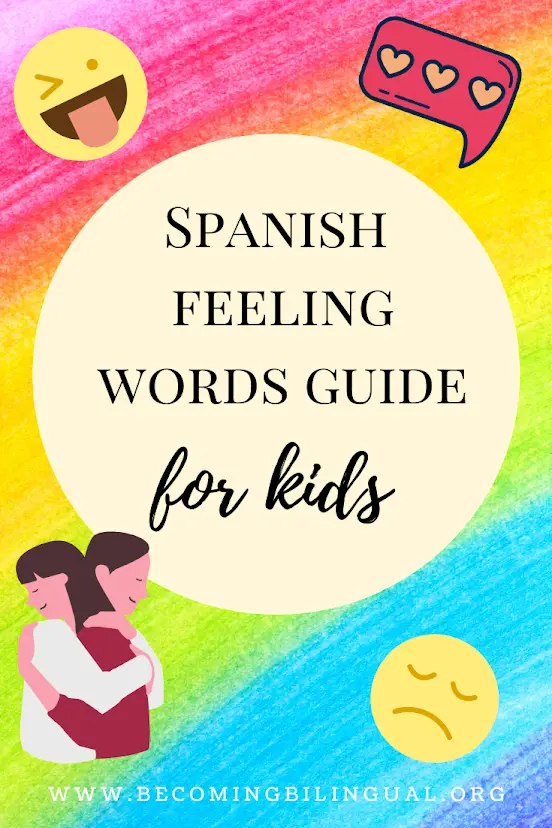How To Talk About Feelings In Spanish

Last Updated on March 26, 2022 by Reina Victoria
Learning Spanish through themes is one of the best ways to make language learning concrete.
Being able to talk about your feelings and emotions is an essential tool for language learning. It’s also a great way to connect with your child when learning a new language together.
When I first started learning Spanish with my daughter I started by asking her how she felt every morning when she woke up. Not only was this a great way to start our day and connect, but it made Spanish language practice part of our daily routine in the morning.
In this article we’ll go through the basic Spanish words and phrases used to talk about feelings and then I’ll share several Spanish resources that can support further work with feelings/emotions vocabulary in Spanish.
This post contains affiliate links. If you click an affiliate link and make a purchase, I earn a small commission which supports this blog at no additional cost to you. Please see the Privacy Policy for details. Thank you for supporting me!
Table of Contents
Spanish Feelings Words and Phrases
Here are some common Spanish feeling words that you can start to practice with your child. Eventually you’ll want to add more targeted words depending on what you want to describe, where you are and what the situation it. This list can get you started with describing basic feelings and emotions in Spanish.
siento/ me siento (I feel)
estoy (I am)
los sentimientos (feelings)
alegre (cheerful)
contento (content)
bien (good)
feliz (happy)
exhausto (exhausted)
cansado (tired)
fatigado (fatigued)
agotado (worn out)
triste (sad)
mal (bad)
deprimido (depressed)
horible (horrible)
furioso (furious)
enojado (angry)
enfadado (upset)
frustrado (frustrated)
¿Como sientes hoy? (How do you feel today?)
¿Como estas? (How are you?)
A note about feeling words in Spanish – feeling words are adjectives that change based on the gender of the person using them. For example, a female might say, “estoy cansada” whereas a male might say, “estoy cansado”.
Spanish Feelings Quick Start Guide
There’s a lot of vocabulary when it comes to talking about feelings and emotions, and it can be overwhelming at first. I created a “Quick Start Guide” with some phrases, questions and answers that are already conjugated to help you start talking in Spanish right away.
You can refer to this guide for yourself if you’re learning Spanish as well. It can also be used as reference for your child. When they are first learning to talk about feelings, they can point to the relevant picture or read the Spanish translation.

Talking About Feelings With Children
Talking about feelings with children is so important – in any language! Making time to address your child’s feelings and talk about them will build their second language and emotional vocabulary. Here’s a way that you could start out talking about feelings each day, just like I started each morning with my daughter.
“¡Buenos días! ¿Cómo sientes hoy? ¿Cómo estás? or “Good Morning! How do you feel today? How are you?”
Tell your child that they can respond with “Estoy” or “Me siento” (“I am” or “I feel”).
Even if they don’t know the Spanish word for their feelings , they can practice using the phrasing, “Estoy tired!” If the word that they want to use is on the quick start guide, help them to find it, “Estoy cansado”.
Once you start using these phrases daily, they’ll come more naturally and you and your child will start to memorize them. As you become more proficient you can research more Spanish vocabulary to support your talk about feelings.
When your child has more Spanish vocabulary you can prompt them, “porque sientes asi?” or “why do you feel this way”?
Even if they can’t describe their reasoning in Spanish, it’s a great segue to continue talking about feelings and situations that cause different emotions to arise.
The more that you work with the phrases and practice using them around the house, the more that they will become automatic and you and your child will have them memorized!

Spanish Resources for Feelings and Emotions
In order to boost your Spanish language time, it’s important to hear and engage with as much Spanish language as possible.
If you stick with the feelings theme there are several songs and websites that can support your vocabulary and learning.
Recommended: How To Practice Mindfulness With Kids – In Spanish
Spanish Feelings Songs
When you’re learning a new language, listening to music can be a great way to increase your language input time.
There are several Spanish feelings songs that are great for supporting your work with color words and vocabulary. Here are some of our family favorites that we’ve enjoyed:
Second Step in Spanish: SecondStep is a great social/emotional program for children that is used in many private practices and public schools. This particular video can be found for free on YouTube and is a great introduction to the basic feelings and how you can tell how a person is feeling from their facial expressions and body language.
While the video has English text, the song is completely in Spanish. I recommend checking out some of their other songs as well!
Escuela de Aprendices: This is actually a short Spanish video that talks about the main feeling words in Spanish and describes them. It also shows different feeling faces and describes why people might feel that way.
Websites With Spanish Feelings Resources
When you’re working with a theme, you’ll want to be able to access a variety of resources. Here are two other websites that have good Spanish feeling resources that you can use for learning with your family.
Spanish Playground: There is a whole resource page dedicated to feeling activities. It includes book lists and printables for working with emotions in Spanish.
Spanish Academy: This site has a really complete guide for talking about emotions and exploring different grammatical patterns when talking about feelings in Spanish. They also have a link to a free PDF with more specific feeling words.
Spanish Feeling Books
Reading in Spanish is a great way to include Spanish comprehensible input into your day. Books are a great way to talk about feelings and emotions in Spanish because you can study the character’s face and body when reading and understand how they’re feeling from context. Here are some of our family’s favorite books to use when talking about feelings.

Todd Parr has a lot of great concept books for kids. His feelings book supports understanding with simple text and colorful images. We’ve really enjoyed this book of “sentimientos”.
Recommended: A Color Word Guide In Spanish
There are so many ways to incorporate feeling vocabulary into your day. Start small and keep practicing your Spanish with these simple starts.
Happy Learning!
Don’t forget to subscribe here and get my latest posts and resources delivered directly to your inbox!

